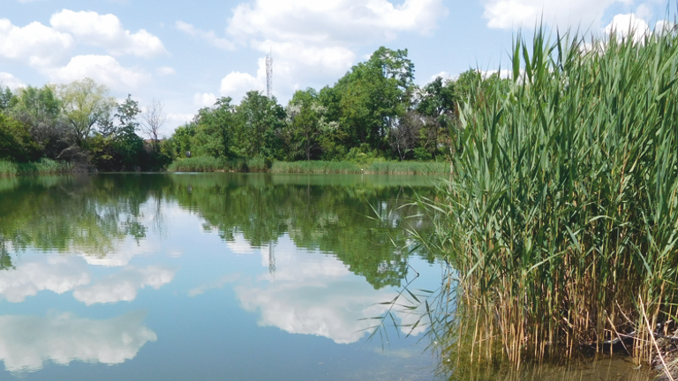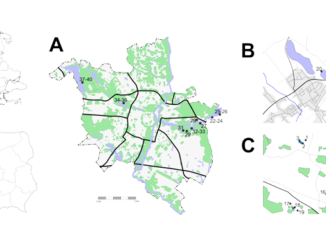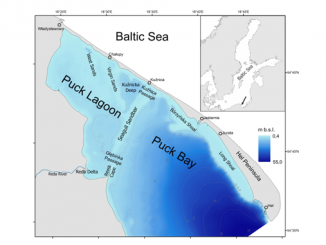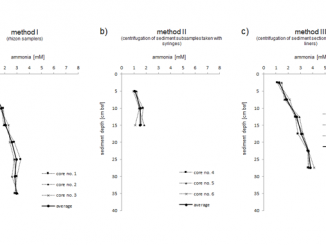
Paper category: Original research paper
Corresponding author: Agnieszka Sowa (agsowa@us.edu.pl)
DOI: 10.1515/ohs-2018-0006
Received: 9 June 2017
Accepted: 25 August 2017
Full text: here
Citation (APA style):
Abstract
To date, no studies have been conducted on macroinvertebrate communities in coal mine settling ponds used for temporary retention of saline mine waters. The objective of the research was to evaluate which habitat – Ruppia maritima, Phragmites australis or sediments without macrophytes – is the most favorable for the abundance and biomass of macroinvertebrate communities. The study was carried out in a hyposaline settling pond located in a mining and urban area in southern Poland. At this time, it is the only inland locality of R. maritima in Poland.
In the studied coal mine settling pond, the non-native, euryhaline amphipod Gammarus tigrinus dominated in the communities on all the habitats. The abundance of other taxa was small and similar on each type of substrate; only Corixidae were much more abundant on the widgeon grass beds. The highest abundance and biomass of macroinvertebrates was recorded at the sites with
R. maritima. Our study highlights the importance of coal mine settling ponds as a substitute habitat for salt-tolerant invertebrates.
References
Alonso, A. & Castro-Díez, P. (2008). What explains the invading success of the aquatic mud snail Potamopyrgus antipodarum (Hydrobiidae, Mollusca)? Hydrobiologia 614: 107–116. DOI: 10.1007/s10750-008-9529-3.
Alonso, A. & Castro-Díez, P. (2012). The exotic aquatic mud snail Potamopyrgus antipodarum (Hydrobiidae, Mollusca): state of the art of a worldwide invasion. Aquat. Sci. 74: 375–383. DOI: 10.1007/s00027-012-0254-7.
Arle, J. & Wagner, F. (2013). Effects of anthropogenic salinisation on the ecological status of macroinvertebrate assemblages in the Werra River (Thuringia, Germany). Hydrobiologia 701: 129–148. DOI: 10.1007/s10750-012-1265-z.
Ba, J., Hou, Z., Platvoet, D., Zhu, L. & Shuqiang, L. (2010). Is Gammarus tigrinus (Crustacea, Amphipoda) becoming cosmopolitan through shipping? Predicting its potential invasive range using ecological niche modeling. Hydrobiologia 649: 183–194. DOI: 10.1007/s10750-010-0244-5.
Barnes, R.S.K. & Ellwood, M.D.F. (2012). Spatial variation in the macrobenthic assemblages of intertidal seagrass along the long axis of an estuary. Est. Coast. Shelf. Sci. 112: 173–182. DOI: 10.1016/j. ecss.2012.07.013.
Bartolini-Rosales, J.L., Reyes-Aldana, H. & Gómez-Ponce, M.A. (2016). New records of Erichsonella attenuate (Isopoda: Valvifera: Idoteidae) in the Gulf of Mexico. Revista Mexicana de Biodiversidad 87: 523–526. DOI: 10.1016/j. rmb.2016.03.004.
Bäthe, J. & Coring, E. (2011). Biological effects of anthropogenic salt – load on the aquatic Fauna: A synthesis of 17 years of biological survey on the rivers Werra and Weser.
Limnologica 41: 125–133. DOI: 10.1016/j. limno.2010.07. 005.
Bielańska-Grajner, I. & Cudak, A. (2014). Effects of salinity on species diversity of rotifers in anthropogenic water bodies. Pol. J. Environ. Stud. 23: 27–34.
Boström, Ch. & Bonsdorff, E. (2000). Zoobenthic community establishment and habitat complexity – the importance of seagrass shoot-density, morphology and physical disturbance for faunal recruitment. Mar. Ecol. Prog. Ser. 205: 123–138. DOI: 10.3354/meps205123.
Bousfield, E.L. (1969). New records of Gammarus (Crustacea: Amphipoda) from the middle Atlantic region. Chesapeake Science 10(1): 1–17.
Braukmann, U. & Böhme, D. (2011). Salt pollution of the middle and lower sections of the river Werra (Germany) and its impact on benthic macroinvertebrates. Limnologica 41: 113–124. DOI: 10.1016/j. limno.2010.09.003.
Brock, M.A. & Shiel, R.J. (1983). The composition of aquatic communities in saline wetlands in Western Australia. Hydrobiologia 105: 77–84. DOI: 10.1007/BF00025178.
Cañedo-Argüelles, M., Bundschuh, M., Gutiérrez-Cánovas, C., Kefford, B.J., Prat, N. et al. (2014). Effects of repeated salt pulses on ecosystem structure and functions in a stream mesocosm. Sci. Total Environ. 476–477: 634–642. DOI: 10.1016/j.scitotenv.2013.12.067.
Canton, S.P. & Ward, J.V. (1981). Benthos and zooplankton of coal strip mine ponds in the mountains of northwestern Colorado, U.S.A. Hydrobiologia 85: 23–31. DOI: 10.1007/BF00011342.
Casagranda, C., Dridi, M.S. & Boudouresque, Ch.F. (2006). Abundance, population structure and production of macro-invertebrate shredders in a Mediterranean brackish lagoon, Lake Ichkeul, Tunisia. Est. Coast. Shelf. Sci. 66: 437–446. DOI: 10.1016/j. ecss.2005.10.005.
Chester, E.T. & Robson, B.J. (2013). Anthropogenic refuges for freshwater biodiversity: their ecological characteristics and management. Biol. Conserv. 166: 64–75. DOI: 10.1016/j.biocon.2013.06.016.
Cuttelod, A., Seddon, M. & Neubert, E. (2011). European Red List of Non-marine Molluscs. Luxembourg: Publications Office of the European Union.
Echols, B.S., Currie, R.J. & Cherry, D.S. (2009). Influence of conductivity Influence of Conductivity Dissipation on Benthic Macroinvertebrates in the North Fork Holston River, Virginia
Downstream of a Point Source Brine Discharge during Severe Low-Flow Conditions. Hum. Ecol. Risk Assess. 15(1): 170–184. DOI: 10.1080/10807030802615907.
Fredette, T.J., Diaz, R.J. & van Montfrans, J. (1990). Secondary production within a seagrass bed (Zostera marina and Ruppia maritima) in lower Chesapeake Bay, USA. Ecology 12: 9–15. DOI: 10.2307/1351787.
Gee, J.H.R., Smith, B.D., Lee, K.M. & Griffirths, S.W. (1997). The ecological basis of freshwater pond management for biodiversity. Aquat. Conserv. Mar. Freshwat. Ecosyst. 7: 91–104. DOI: 10.1002/(SICI)1099-0755(199706).
Gledhill, D.G., James, P. & Davies, D.H. (2008). Pond density as a determinant of aquatic species richness in an urban landscape. Landsc. Ecol. 23: 1219–1230. DOI: 10.1007/s10980-008-9292-x.
Głowaciński, Z. & Nowacki, J. (2004). Polish Red Data Book of Animals. Invertebrates. Kraków – Poznań: IOP PAN & AR (In Polish).
Grabowski, M., Bącela, K., Konopacka, A. & Jażdżewski, K. (2009). Salinity-related distribution of alien amphipods in rivers provides refugia for native species. Biol. invasions 11: 2107–2117. DOI: 10.1007/s10530-009-9502-8.
Guerrini, A., Colangelo, M.A. & Ceccherelli, V.U. (1998). Recolonization patterns of meiobenthic communities in brackish vegetated and unvegetated habitats after induced hypoxia/anoxia. Hydrobiologia 375/376: 73–87. DOI: 10.1007/978-94-017-2864-5_7.
Hammer, U.T., Sheard, J.S. & Kranabetter, J. (1990). Distribution and abundance of littoral benthic fauna in Canadian prairie saline lakes. Hydrobiologia 197: 173–192. DOI: 10.1007/BF00026949.
Hassall, C. (2014). The ecology and biodiversity of urban ponds. WIREs Water. 1: 187–206. DOI: 10.1002/wat2.1014.
Heck, K.L., Able, K.W., Roman, C.T. & Fahay, M.P. (1995). Composition, abundance, biomass and production of macrofauna in New England estuary: Comparisons among eelgrass meadows and other nursery habitats. Estuaries 18: 379–389. DOI: 10.2307/1352320.
Henninger, T.O., Froneman, P.W., Richoux, N.B. & Hodgson, A.N. (2009). The role of macrophytes as a refuge and food source for the eustarine isopod Exosphaeroma hylocoetes (Bernard, 1940). Est. Coast. Shelf. Sci. 82: 285–293. DOI: 10.1016/j. ecss.2009.01.017.
Herbst, D.B., Medhurst, R.B., Roberts, S.W. & Jellison, R. (2013). Substratum associations and depth distribution of benthic invertebrates in saine Walker Lake, Nevad, USA. Hydrobiologia 700: 61–72. DOI: 10.1007/s10750-012-1219-5.
Hermanowicz, W., Dojlido, J., Dożańska, W., Koziorowski, B. & Zerbe, J. (1999). Physical and chemical studies of water and wastewater. Warszawa: Arkady (In Polish).
Hill, M.J., Ryves, D.B., White, J.C. & Wood, P.J. (2016). Macroinvertebrate diversity in urban and rural ponds: Implications for freshwater biodiversity conservation. Biol. Cons. 201: 50–59. DOI: 10.1016/j.biocon.2016.06.027.
Hill, M.J., Biggs, J., Thornhill, J., Briers, R.A., Gledhill, D.G. et al. (2017). Urban ponds as an aquatic biodiversity resource in modified landscapes. Glob. Chang. Biol. 23(3): 986–999. DOI: 10.1111/gcb.13401.
Hutchinson, G.E. (1937). A contribution to the limnology of arid regions. Trans. Conn. Acad. Arts. Sci. 33: 47–132.
Jaruchiewicz, E. (2014). The role of anthropogenic water reservoirs within the landscapes of mining areas – a case study from the western part of the Upper Silesian Coal Basin. Environ. Socio-econ. Stud. 2: 16–26.
Kang, S.R. & King, S.L., (2012). Influence of salinity and prey presence on the survival of aquatic macroinvertebrates of a freshwater marsh. Aquat. Ecol. 46: 411–420. DOI: 10.1007/s10452-012-9410-3.
Keats, R.A. & Osher, L.J. (2007). The Macroinvertebrates of Ruppia (Widgeon Grass) Beds in a Small Maine Estuary. Northeastern Naturalist 14(3): 481–491. DOI: 10.1656/1092-6194(2007)14[481:TMORWG]2.0.CO;2.
Kornijow, R., Gulati, R.D. & van Donk, E. (1990). Hydrophyte-macroinvertebrate interactions in Zwemlust, a lake undergoing biomanipulation. Hydrobiologia 200: 467–474. DOI: 10.1007/BF02530364.
Lazar, A.C. & Dawes, C. (1991). A seasonal study of the seagrass Ruppia maritima L. in Tampa Bay, Florida. Organic constituents and tolerances to salinity and temperature. Bot. Mar. 34: 265–269. DOI: 10.1007/s12526-010-0050-3.
Leopardas, V., Uy, W. & Nakaoka, M. (2014). Benthic macrofaunal assemblages in multispecific seagrass meadows of the southern Philippines: Variation among vegetation dominated by different seagrass species. J. Exp. Mar. Biol. Ecol. 457: 71–80. DOI: 10.1016/j. jembe.2014.04.006.
Lewin, I. & Smoliński, A. (2006). Rare, threatened and alien species in the gastropod communities in the clay pit ponds in relation to the environmental factors (The Ciechanowska Upland, Central Poland). Biodivers. Conserv. 15(11): 3617–3635. DOI: 10.1007/s10531-005-8347-4.
Luek, A. & Rasmussen, J.B. (2017). Chemical, Physical and Biological Factors Shape Littoral Invertebrate Community Structure in Coal-Mining End-Pit Lakes. Environ. Manage. 59: 652–664. DOI: 10.1007/s00267-017-0819-2.
Marszewska, L, Dumnicka, E. & Normant-Saremba, M. (2017). New data on benthic Naididae (Annelida, Clitellata) in Polish brackish waters. Oceanologia 59: 81–84. DOI: 10.1016/j. oceano.2016.06.003.
Martínez-Abraín, A. & Jiménez, J. (2016). Anthropogenic areas as incidental substitutes for original habitat. Conserv. Biol. 30(3): 593–598. DOI: 10.1111/cobi.12644.
Milbrik, G. & Timm, T. (2001). Distribution and dispersal capacity of the Ponto-Caspian tubificid oligochaete Potamothrix moldaviensis Vejdovský et Mrázek, 1903 in the Baltic Sea Region. Hydrobiologia 463: 91–102. DOI: 10.1023/A:1013139221454.
Montague, C.L. & Ley, J.A. (1993). A possible effect of salinity fluctuation on abundance of benthic vegetation and associated fauna in Northeastern Florida Bay. Estuaries 16: 703–717. DOI: 10.2307/1352429.
Murkin, E.J., Murkin, H.R. & Titman, R.D. (1992). Nektonic invertebrate abundance and distribution at the emergent vegetation-open water interface in the Delta Marsh, Manitoba, Canada. Wetlands 12: 45–52. DOI: 10.1007/BF03160543.
Myślińska, E. (2001). Organic and laboratory land testing methods. Warszawa: PWN (In Polish).
Nowak, A., Nowak, S. & Czerniawska-Kusza, I. (2007). Rare and threatened pondweed communities in anthropogenic water bodies of Opole Silesia (SW Poland). Acta Soc. Bot. Pol. 76(2): 151–163. DOI: 10.5586/asbp.2007.019.
Pakulnicka, J. (2008). The formation of water beetle fauna in anthropogenic water bodies. Oceanol. Hydrobiol. St. 37: 31–43. DOI: 10.2478/v10009-007-0037-y.
Petruck, A. & Stöffler, U. (2011). On the history of chloride concentrations in the River Lippe (Germany) and the impact on the macroinvertebrates. Limnologica 41: 143–150. DOI: 10.1016/j. limno.2011.01.001.
Piscart, C., Moreteau, J.C. & Beisel, J.N. (2005). Biodiversity and structure of macroinvertebrate communities along a small permanent salinity gradient (Meurthe River, France). Hydrobiologia 551: 227–236. DOI: 10.1007/s10750-005-4463-0.
Piscart, C., Moreteau, J.C. & Beisel, J.N. (2006). Monitoring changes in freshwater macroinvertebrate communities along a salinity gradient using artificial substrates. Environ. Monit. Assess. 116: 529–542. DOI: 10.1007/s10661-006-7669-3.
Piscart, C., Kefford, B.J. & Beisel, J.N. (2011). Are salinity tolerances of non-native macroinvertebrates in France an indicator of potential for their translocation in a new area? Limnologica 41: 107–112. DOI: 10.1016/j. limno.2010.09.002.
Por, F.D. (1971). The zoobenthos of the Sirbonian lagoons. Rapp. Comm. int. Mer. Médit. 20(3): 247–249.
Rewicz, A., Kołodziejek, J. & Jakubska-Busse, A. (2016). The role of anthropogenic habitats as substitutes for natural habitats: a case study on Epipactis helleborine (L.) Crantz (Orchidaceae, Neottieae). Variations in size and nutrient composition of seeds. Turk. J. Bot. 40: 258–268. DOI: 10.3906/bot-1404-69.
Sato, M. & Riddiford, N. (2008). A preliminary study of the Odonata of S’Albufera Natural Park, Mallorca: Status, conservation priorities and bio-indicator potential. J. Insect. Conserv. 12: 539–548. DOI: 10.1007/s10841-007-9094-5.
Savage, A.A. (1981). The Gammaridae and Corixidae of an inland saline lake from 1975 to 1978. Hydrobiologia 76: 33–44. DOI: 10.1007/BF00014031.
Triest, L. & Sierens, T. (2009). High diversity of Ruppia meadows in saline ponds and lakes of the western Mediterranean. Hydrobiologia 634: 97–105. DOI: 10.1007/978-90-481-9088-1_21.
van Haaren, T., Timm, T. & Erséus, C. (2017, May). Paranais litoralis (Müller, 1780). Retrieved June 07, 2017, from World Register of Marine Species http://www.marinespecies.org/aphia.php?p=taxdetails&id=137485.
Velasco, J., Millán, A., Hernández, J., Gutiérrez, C., Abellán, P. et al. (2006). Response of biotic communities to salinity changes in a Mediterranean hypersaline stream. Saline Systems 2: 12. DOI: 10.1186/1746-1448-2-12.
Verhoeven, J.T.A. (1978). Distribution and Structure of Communities Dominated by Ruppia, Zostera and Potamogeton Species in the Inland Waters of ‘De Bol’, Texel, The Netherlands. Est. Coast. Mar. Sci. 6: 417–428. DOI: 10.1016/0302-3524(78)90132-9.
Verhoeven, J.T.A. (1979). The ecology of Ruppia-dominated communities in Western Europe. Distribution of Ruppia representatives in relation to their autecology. Aquat. Bot. 6: 197–268. DOI: 10.1016/0304-3770(79)90064-0.
Verhoeven, J.T.A. (1980). Synecological classificasion, structure and dynamics of the macroflora and macrofauna communities. Aquat. Bot. 8: 1–85. DOI: 10.1016/0304-3770(80)90044-3.
Vermonden, K., Lauven, R.S.E.W., van der Velde, G., van Katwijk, M.M. Roelofs, J.G.M. et al. (2009). Urban drainage systems: an undervalued habitat for aquatic macroinvertebrates. Biol. Conserv. 142: 1105–1115. DOI: 10.1016/j.biocon.2009.01.026.
Wenner, E.L. & Beatty, H.R. (1988). Macrobenthic communities from wetland impoundments and adjacent open marsh habitats in South Carolina. Estuaries 11: 29–44. DOI: 10.2307/1351715.
Williams, W.D. & Williams, N.E. (1998). Aquatic insects in an estuarine environment: Densities, distribution and salinity tolerance. Freshwat. Biol. 39: 411–421. DOI: 10.1046/j.1365-2427.1998.00285. x.
Wilson, J.G. & Koutsagiannopolou, V. (2014). Abundance, biomass and productivity of invertebrate hyperbenthos in a temperate saltmarsh creek system. Hydrobiologia 728: 141–151. DOI: 10.1007/s.10750-014-1813-9.
Wollheim, W.M. & Lovvorn, J.R. (1995). Salinity effect on macroinvertebrate assemblages and waterbird food webs in shallow lakes of the Wyoming High Plains. Hydrobiologia 310: 207–223. DOI: 10.1007/BF00006832.
Wollheim, W.M. & Lovvorn, J.R. (1996). Effects of macrophyte growth forms on invertebrate communities in saline lakes of the Wyoming High Plains. Hydrobiologia 323: 83–96. DOI: 10.1007/BF00017586.




Bądź pierwszy, który skomentuje ten wpis